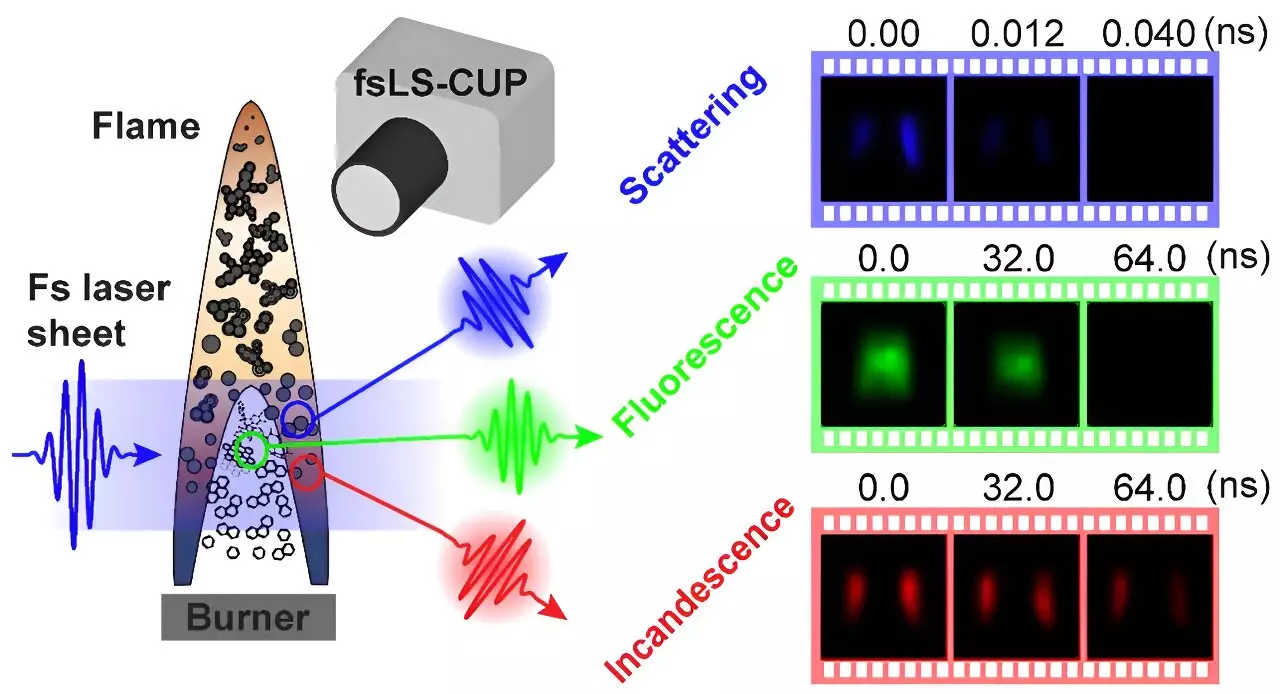The intersection of science and technology frequently births innovations that redefine our understanding of the universe and its complex phenomena. One such breakthrough comes from a recent study led by a collaborative team at the California Institute of Technology and Friedrich-Alexander University Erlangen, where researchers introduced the femtosecond laser sheet-compressed ultrafast photography (fsLS-CUP). This novel imaging technique represents a significant leap forward in capturing transient phenomena, particularly in the study of polycyclic aromatic hydrocarbons (PAHs) and soot particles in flames—substances that hold immense importance in both environmental and astrophysical contexts.
The Challenge with Traditional Imaging Techniques
For years, the scientific community has struggled with capturing the fleeting moments of combustion reactions. Traditional imaging techniques, often limited to a few million frames per second, simply cannot keep pace with the rapid transformations occurring in flames or during the combustion of complex hydrocarbons. These limitations often require researchers to rely on sequential imaging, stitching together multiple frames to create a coherent picture of dynamic processes. This piecemeal approach can miss critical moments, leaving researchers at a disadvantage when trying to understand the intricate dance of particles and chemical reactions.
The short-lived nature of PAHs and soot in combustion environments—lasting only billionths of a second—poses a significant challenge for researchers. The need for rapid and comprehensive observation methods has never been more pressing, particularly as these carbon-based compounds are not only ubiquitous in terrestrial environments but also prevalent in space, forming a substantial portion of interstellar matter. The complexity of capturing their behavior further solidifies the need for a revolutionary solution in the field of ultrafast imaging.
In response to these challenges, the researchers have developed fsLS-CUP, which boasts a staggering imaging speed of 250 billion frames per second—20,000 times faster than prior technology. Utilizing a single femtosecond laser pulse, this groundbreaking technique allows for wide-field, real-time imaging of laser-induced fluorescence and heating phenomena, as well as scattering events from soot interactions. This single-shot capture method eliminates the shortcomings of previous methods that typically required multiple laser pulses, thereby reducing the risk of adverse heating effects during experimentation.
Dr. Yogeshwar Nath Mishra, one of the lead researchers, emphasized the profound implications of this technique not only for understanding hydrocarbon behaviors in flames but also across various scientific disciplines including chemistry, biology, and environmental science. The technique’s application extends to observing PAH formation and soot dynamics, which have relevance in both fundamental science and in practical applications such as improving combustion efficiency or reducing pollution.
The fsLS-CUP technique does not just represent a technical marvel; it opens a door for future research possibilities. By enhancing our understanding of the fleeting moments of chemical reactions and particle interactions, this innovation aligns with broader scientific goals, including NASA’s interest in exploring the origins of life and cosmic evolution. As researchers decode the mysteries of PAH formation, particularly in extreme environments like carbon-rich stars, our comprehension of life’s building blocks could expand significantly.
Furthermore, Dr. Florian Bauer noted that fsLS-CUP’s ability to simultaneously capture spatial and temporal details paves the way for observing a range of phenomena, including rapid chemical reactions in various materials. The innovation behind compressed sensing employed in FsLS-CUP makes it versatile for different applications, heralding possibilities across multiple scientific fields.
The introduction of femtosecond laser sheet-compressed ultrafast photography represents a watershed moment in the quest to understand rapid transient phenomena in combustion science and beyond. The capacity to capture 250 billion frames per second not only propels the field of ultrafast imaging technology into new realms but also sets the stage for future discoveries that could reshape our understanding of the universes in which we live.
As researchers continue to push the boundaries of speed and precision in imaging techniques, the excitement surrounding fsLS-CUP resonates across scientific disciplines, ushering in a new era of inquiry that promises to unlock secrets hidden in the brief yet vital moments of chemical interactions. The potential benefits of this technology are vast, from improved energy solutions to deeper insights into the cosmos, making it a quintessential advancement in the field of modern science.

